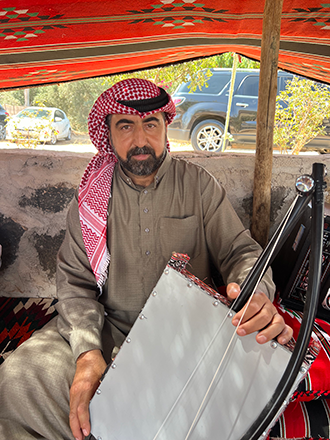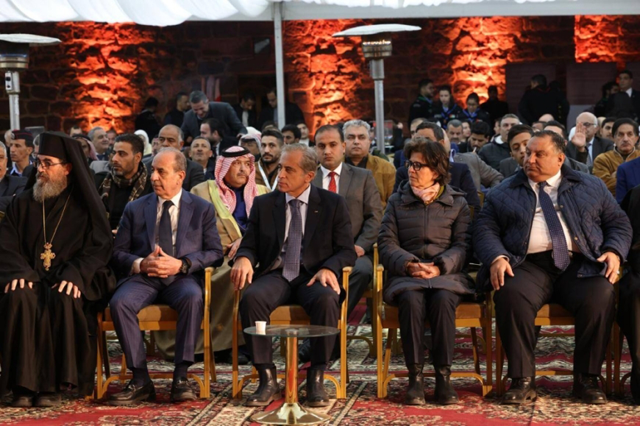AMMAN — In the heart of Umm Jimal, a community of 45,000 residents are making a living through selling handicrafts and engaging in the tourism activity of their ancient city, which recently has joined the UNISCO World Heritage list.
In such business, locals are building on Jordan's deep-rooted tradition in artisanal craftsmanship, which dates back over 5,000 years. As a key trade hub along the ancient Silk Road, the exchange of knowledge, culture, art, and religion was facilitated and fostered a unique blend of artistic influences from different civilisations. The Nabateans, renowned merchants who once controlled these trade routes, were highly skilled in crafts such as ceramics.
Traditionally, Jordanian women, especially among Bedouin families, produced all the necessary items for their households. While modern conveniences have largely replaced this practice, many skills continue to be passed down through generations.
Mahmoud Arinat from the University of Jordan explained in a paper that these
crafts have a significant potential to boost the economy and tourism sector, while also preserving local traditions.
They involve simple techniques, use local materials and require low capital investment, making them a practical means of supporting rural development and reducing urban migration, the professor said in the paper published by the university.
Economic alliance
Recently added to the UNESCO World Heritage site, Umm Jimal, in the northeastern city of Mafrqa, is transforming the historical significance of its archaeological site into an economic engine, through a strategic alliance with the Ministry of Tourism and Heritage, the Ministry of Investment, the Ministry of Media, and the people of Mafraq governorate, according to Hassan Rahiba, the director of Umm Jimal municipality. “We are witnessing a symphony of collaboration where everyone is involved."
During a recent press tour of the site, the Ministry of Investment announced an upcoming conference involving investors to promote the area.
This investment is expected to generate employment, particularly for women and youth, aligning with His Majesty King Abdullah’s modernisation plan, Rahiba added.
The municipality is also focused on developing the cultural skills of its residents, now a primary income source for Umm Jimal. Efforts include improving tourist interactions, with an emphasis on music and handicrafts as unique travel souvenirs.
"The international recognition we have achieved is a testament to the dedication of our community," Rahiba said. "We are confident in our ability to attract interest from other cities and enhance our economic standing through tourism."
Local community
The municipality supports six specialised associations and production kitchens operated by women, youth, and elders. Rahiba highlighted the local population’s commitment to their heritage and their readiness to welcome visitors.
Samiha Masaeed, President of the Umm Jimal Heritage Preservation Association, expressed excitement about Umm Jimal's inscription to the UNESCO World Heritage list. "This recognition will improve community conditions and increase job opportunities."
"Our association welcomes girls of all ages to sell their products, including basalt carvings, jewellery, and embroidery to carpets and handmade goods like dairy products and soap. These items are sold at bazaars and near the archaeological site," Masaeed said.
Jordanian handicrafts include traditional textile, embroidery, stone carved pieces, carving on wood, carving in copper and white metal, pottery and ceramics, glass, sheep wool, sand bottles, mother of shells, leather, jewelry and precious stones, mosaic, musical instruments, daggers, carpets and mats, traditional costumes, according to Arinat. Some regions are famous for specific handcrafts, such as Madaba for the mosaics.
Seventy-year-old Farha Sobhi, an old-time member of the association, said weaving carpets from sheep's wool has been a lifelong passion, a skill she has honed since she was 20 years old.
Ziad Masry, a musician who plays the Rababa, a traditional stringed instrument, said, "This musical tradition plays an important role in preserving Badia's cultural heritage. When I am playing Rababa, I am showcasing my ancestors' heritage and helping to spread our culture to the entire world."
Spirit of Jordan
According to the USAID Jordan Tourism Development Project, handcrafted items embody both the tangible and intangible aspects of Jordan’s cultural heritage.
Handcrafts from Umm Jimal are more than just souvenirs; they are integral to Jordan’s tourism strategy and cultural preservation efforts. The United Nation World Tourism Organisation (UNWTO) stated that souvenirs often serve as a tangible reminder of travel experience and cultural encounters. For tourists, these handcrafted items are not just mementos but symbols of their connection to the places they visit.















